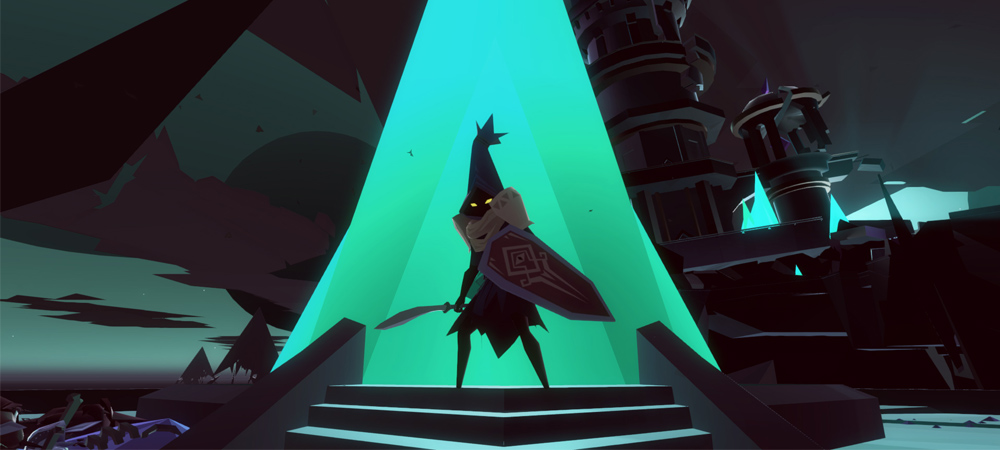Murderous beauty
As I explored the opening area of Harebrained Schemes’ third-person action roguelike Necropolis at PAX East 2015, I discovered an inviting treasure chest. Upon opening it, I realized too late that I wasn’t alone in that first room. While my back was turned, a shadowy, crystalline figure called the Grine had seized the opportunity to launch a flurry of attacks at my unprotected rear; all the while, my character stood there helplessly locked in place throughout the chest’s opening animation.
It was at this point in the Necropolis demo that the game made complete sense to me. In that singular moment I felt as though I’d been here many times before. Not here in the literal sense of playing the demo beforehand, of course, but here in that the game’s unspoken rules were so familiar to me that it felt like coming home. And what a treacherous home it is.
It’s become passé to compare titles to the Souls games, but in this particular instance, I feel the comparison is completely justified. Anyone familiar with From Software’s work will know, almost instinctively, what will be expected of them when they pick up the controller. The control scheme (light and heavy attack buttons, shield, jump, and evasion) and stamina system are very much in line with what we’re used to in those titles, with a couple of notable deviations.
Necropolis doesn’t feature a parrying system, for starters. Instead, your character can use their equipped shield to perform a bash maneuver as well as block incoming attacks. However, stamina is drained when doing so and should be used sparingly in battle. For example, if you try to hold off enemy attacks with the shield indefinitely, you’ll soon wear yourself out as your enemy lands each attack, thereby leaving your character susceptible to taking damage.

Another noteworthy difference between the games is the absence of a rolling mechanic in Necropolis. The analog in Harebrained’s title is the dash ability — once tapped, your character will hop back a short distance. By limiting the character’s ability to quickly roll out of the way of danger, Necropolis‘ combat feels riskier to me. Obviously, you can use the dash to escape from danger, but the distance you travel is much shorter, so it may take a few stamina-draining hops to get far enough away from an enemy to avoid its attacks.
Before I move on to discussing the game’s environments, I wanted to add one last thing about the combat systems that I found intriguing, and that’s what the team refers to as its “living ecology of threats.” I’d read about it before but with scant details available at the time and wasn’t sure what to make of it. In the demo, however, its use was made very clear — the Gem Eater, or as we’ve described him, the Shark Man — has an insatiable appetite for (you guessed it) gems. And, as it happens, the Grine creatures mentioned before are composed of a crystalline substance that the hulking monster finds irresistible.
Mike McCain, art director for the project, tipped me off on this, suggested that instead of going toe to toe with the brute that perhaps I should use him to my advantage instead. McCain pointed out a nearby mob of Grine and advised me to kite the beast in, letting him do what came naturally. As soon as he spotted his prey, he forgot about me entirely and began battling my foes for me. This opened up a wonderful tactical opportunity as I could swiftly and safely move in for a few strikes, gradually chipping away at his health before inevitably having to face off with him by myself once he was through with the Grine.
Where Necropolis really sets itself apart is outside of combat, however. As you can see in MMORPG’s footage of the PAX demo above, the procedurally generated environments have a stylish and clean look to them, standing in stark contrast to the oppressively gritty-looking From titles that helped inspire it. Necropolis‘ gorgeous low-poly environments look almost dream-like in their abstract, geometric structure and layout. It’s quite impressive, really. For a title that’s going for such a minimalistic design, the effect is paradoxically lavish when taken in as a whole.

The game also differentiates itself from typical roguelikes in its approach to level design. Harebrained Schemes manages to trick the eye in the way that it handles the procedural elements; the end effect looks more like preplanned environments than randomly assembled rooms tacked together. If you didn’t know that the levels were being procedurally generated with each new game, it would be easy to come away thinking that the layouts you’d just played were static. I’m not sure if it’s the utilization of wide-open spaces where you can look out into the distance or stare down into an abyss that makes it feel so, but in any case, the effect works very well.
Out of all the titles that I saw at this year’s PAX East, it was a no-brainer to choose Harebrained Schemes’ stunning new action-roguelike as one of the two games that I would select for my editor’s choice awards for the show. Its elegant and thoughtful combat, both familiar and new, was an absolute pleasure to experience firsthand. For fans of third-person action games, especially those who enjoy From Software’s titles, Necropolis is one to fix firmly on your radar.





Published: Mar 10, 2015 06:30 pm